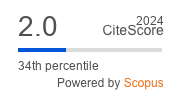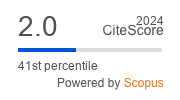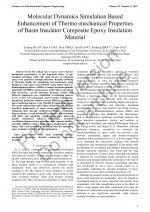| 2/2025 - 1 | View TOC | « Previous Article | Next Article » |
Molecular Dynamics Simulation Based Enhancement of Thermo-mechanical Properties of Basin Insulator Composite Epoxy Insulation MaterialDUAN, Y. |
| Extra paper information in |
| Click to see author's profile in |
| Download PDF |
Author keywords
epoxy resin, basin insulators, thermo-mechanical properties, thermal conductivity, molecular dynamics
References keywords
epoxy(31), molecular(22), dynamics(17), resin(16), properties(15), polymer(14), simulation(11), mechanical(11), cross(8), voltage(7)
Blue keywords are present in both the references section and the paper title.
About this article
Date of Publication: 2025-06-30
Volume 25, Issue 2, Year 2025, On page(s): 3 - 10
ISSN: 1582-7445, e-ISSN: 1844-7600
Digital Object Identifier: 10.4316/AECE.2025.02001
Abstract
Given the critical role of epoxy resin's thermo-mechanical performance in the long-term safety of gas-insulated switchgear (GIS), this study focuses on enhancing epoxy resin properties through molecular dynamics modeling in Materials Studio. By considering real components, using bisphenol A-type epoxy resin (DGEBA) as the matrix with 3,3-diaminodiphenylsulfone (33DDS) or methyl-tetrahydrophthalic anhydride (MeTHPA) curing agents, Al2O3 filler, and phenol (Ph) accelerator, several molecular dynamics models with different components were established. Crosslinking analyses in 0% to 93% were performed via Perl scripts, with thermo-mechanical properties analyzed across different components and crosslinking degrees in the 250-600 K temperature range. The results indicate that Al2O3 fillers effectively raise the glass transition temperature of epoxy resins while significantly enhancing their thermal conductivity. Higher crosslinking degrees enhance overall mechanical properties, while formulas with fillers and anhydride curing agents show improved specific mechanical indices. Additionally, increased crosslinking degrees elevate molecular chain segment mobility, and filler addition reduces mean square displacement curve slopes. This work provides a theoretical base for optimizing epoxy insulation reliability in GIS applications. |
| References | | | Cited By |
Information from Web of Science® will be displayed on the next page reload.
We were unable to retrieve information about this paper in SCOPUS®.
Message: [Returned results: 0]
There are no citing papers in the CrossRef Cited-by Linking system.
Disclaimer: All information displayed above was retrieved by using remote connections to respective databases. For the best user experience, we update all data by using background processes, and use caches in order to reduce the load on the servers we retrieve the information from. As we have no control on the availability of the database servers and sometimes the Internet connectivity may be affected, we do not guarantee the information is correct or complete. For the most accurate data, please always consult the database sites directly. Some external links require authentication or an institutional subscription.
Web of Science® is a registered trademark of Clarivate Analytics, Scopus® is a registered trademark of Elsevier B.V., other product names, company names, brand names, trademarks and logos are the property of their respective owners.
Faculty of Electrical Engineering and Computer Science
Stefan cel Mare University of Suceava, Romania
All rights reserved: Advances in Electrical and Computer Engineering is a registered trademark of the Stefan cel Mare University of Suceava. No part of this publication may be reproduced, stored in a retrieval system, photocopied, recorded or archived, without the written permission from the Editor. When authors submit their papers for publication, they agree that the copyright for their article be transferred to the Faculty of Electrical Engineering and Computer Science, Stefan cel Mare University of Suceava, Romania, if and only if the articles are accepted for publication. The copyright covers the exclusive rights to reproduce and distribute the article, including reprints and translations.
Permission for other use: The copyright owner's consent does not extend to copying for general distribution, for promotion, for creating new works, or for resale. Specific written permission must be obtained from the Editor for such copying. Direct linking to files hosted on this website is strictly prohibited.
Disclaimer: Whilst every effort is made by the publishers and editorial board to see that no inaccurate or misleading data, opinions or statements appear in this journal, they wish to make it clear that all information and opinions formulated in the articles, as well as linguistic accuracy, are the sole responsibility of the author.



